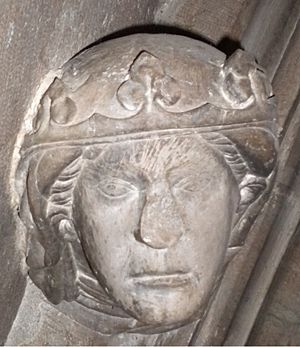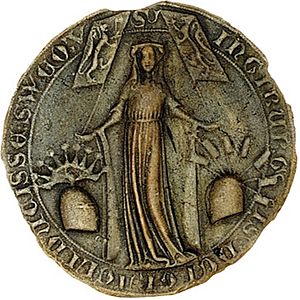Ingeborg Håkonsdatter of Norway facts for kids
Quick facts for kids Ingeborg Håkonsdatter of Norway |
|
|---|---|
| Duchess of Södermanland, Halland, and Estonia | |

Duchess Ingeborg's bust at Linköping Cathedral
|
|
| Born | 1301 Norway |
| Died | 1361 (aged 59–60) |
| Spouse | Eric, Duke of Södermanland Canute Porse, Duke of Halland |
| Issue | Magnus VII of Norway Euphemia, Duchess of Mecklenburg Haakon, Duke of Halland Canute, Duke of Halland |
| House | Sverre |
| Father | Haakon V of Norway |
| Mother | Euphemia of Rügen |
Ingeborg of Norway (born in 1301 – died June 17, 1361) was a Norwegian princess. She became a Swedish duchess through marriage. Ingeborg played a big role in the governments of Norway (1319–27) and Sweden (1319–26). This was during the time her son, Magnus, was too young to rule. From 1319 to 1326, she was the first official female regent of Sweden. A regent is someone who rules a country when the king or queen is too young or unable to rule.
Contents
Life of Ingeborg
Early Years
Ingeborg was born in 1301. She was the only daughter of King Håkon V of Norway and Queen Euphemia. When she was a child, she was first promised to Magnus Birgerson. He was the son of the Swedish King Birger. But this engagement was later called off.
In 1305, she was promised to Eric, Duke of Södermanland. He was King Birger's younger brother. In 1312, Ingeborg and Eric got married in Oslo. At the same time, her cousin, Ingeborg Eriksdottir of Norway, married Eric's brother, Duke Valdemar. Ingeborg and Eric had two children before Duke Eric died.
Leading the Ducal Party
After her husband Eric and his brother Valdemar were put in prison, Ingeborg and her cousin, Ingeborg Eriksdottir, took charge. They led their husbands' supporters. On April 16, 1318, the two duchesses Ingeborg made an agreement in Kalmar. They teamed up with Duke Christoffer of Halland-Samsö from Denmark. They promised to free their husbands. They also agreed not to make peace with the kings of Sweden and Denmark until their husbands were free. Later that year, it was confirmed that their husbands had died.
Becoming a Regent
When her father died, Ingeborg's son, Magnus VII of Norway, became King of Norway at just three years old. Ingeborg was officially named the regent for her son in Norway. Soon after, the Swedish nobles chose young Magnus to be King of Sweden. They removed King Birger from power. Ingeborg was then made the regent of Sweden. She was given a seat and a vote in the Swedish government. Her title was: "Ingeborg, by the Grace of God, daughter of Haakon, duchess in the Kingdom of Sweden."
Duchess Ingeborg had her own court at her home in Varberg. Some letters from 1318-1321 show that powerful Swedish men used Ingeborg's power. They had her sign documents that helped them. This was to thank them for supporting her dead husband and her son Magnus. Ingeborg was the only person who had a seat in both the Swedish and Norwegian regency councils. She also ruled her own lands, which were like small independent areas. She controlled many castles that were important because of their location.
Ingeborg's exact role was not always clear. She was the king's mother, but she was not a queen.
Her Advisors
People criticized Ingeborg because she made political decisions without asking the Swedish and Norwegian councils. She also used her son's royal seal for her own plans. On October 1, 1320, she helped the city of Riga with its debts using her son's name. She was known for giving large gifts to people who supported her.
Canute Porse was one of her husband's supporters. He was made governor of Varberg. Ingeborg liked to have young foreign men around her. People thought these men influenced her decisions. Canute was the most famous of them. On April 12, 1321, the Swedish council told the Norwegian council to advise Ingeborg. They said she should listen more to older, experienced men. They thought she should not listen to young, inexperienced foreign men. A new law was even made that banned foreigners from the Swedish council.
The Scania Plan
Ingeborg and Canute wanted to make Scania, which was part of Denmark at the time, part of Ingeborg's lands. In 1321, Ingeborg arranged for her daughter Euphemia to marry Albert II, Duke of Mecklenburg. The marriage agreement said that Mecklenburg and other areas would help Ingeborg take over Scania. The Norwegian council approved this, but the Swedish council did not.
To pay for the invasion, Ingeborg borrowed money from the city of Stralsund. She promised them free trade in Sweden and Norway as security. When Ingeborg's forces, led by Canute, invaded Scania in 1322–23, Mecklenburg betrayed her. They sided with Denmark, and the plan failed.
Losing Power
In 1322, Ingeborg had a big disagreement with the Swedish regency council. The council decided that no order from Ingeborg would be accepted without their approval. All agreements she made with individual council members were canceled. In 1323, Ingeborg had to agree to these terms. She also had to give up several of her important castles and lands.
On February 20, 1323, the Norwegian regency council also turned against Ingeborg. They accused her of misusing the royal seal. They also said she broke the peace with Denmark and spent too much money. She was replaced as the head of the regency. After 1323, Ingeborg's power was very limited. She could only do what the councils approved. On February 14, 1326, Ingeborg gave up more lands to have her debts paid. She was forced to send Canute away and lost all her political power in the Swedish council. However, her signature was still needed for the peace treaty between Norway and Sönderjylland on June 14, 1327.
Ingeborg married her partner Canute Porse in 1327. He was a noble but not from a royal family. Canute became the Duke of Halland and got Ingeborg's inherited lands. But this marriage was another reason why people in Sweden and Norway did not want Ingeborg to have governmental power. In the same year she married Canute, Ingeborg also lost her power in the Norwegian regency council.
Later Life
Her husband Canute became Duke of Estonia in 1329. In 1330, Ingeborg became a widow again. Her younger sons became dukes of Halland. Her oldest son, Magnus, became an adult in 1332. In the same year, Ingeborg helped Sweden gain control over Scania until 1360. After her second husband died, Ingeborg again became important in her son the king's life. But we don't know how much influence she had on him.
In 1336, Ingeborg welcomed her daughter Euphemia and her son-in-law Albert of Mecklenburg. She also welcomed Rudolf I, Duke of Saxe-Wittenberg, and Henry of Holstein. They came with her own fleet for the coronation of her son and his wife in Stockholm. In 1341, Ingeborg and the counts Henry and Claus of Holstein went to war. They fought against Valdemar of Schleswig, John of Holstein, and the Hanseatic league in Denmark. Ingeborg was staying at Kalundborg in Denmark at the time. King Valdemar IV attacked her there. After two years of fighting and agreements, the issue was settled. King Valdemar got Copenhagen Castle back. King Magnus sealed the peace by telling Valdemar to keep his promise to Ingeborg. In 1350, Ingeborg inherited the title of Duke of Halland from her younger son.
Children and Family
With Eric, Duke of Södermanland, Ingeborg had two children:
- Magnus VII of Norway (1316–1374)
- Euphemia of Sweden, duchess of Mecklenburg (1317–c. 1370)
With Canute Porse, Duke of Halland and Estonia, Ingeborg had three children:
- Haakon, Duke of Halland, died 1350
- Canute, Duke of Halland, died 1350
- Birgitta, who married Jon Hafthorsson and had children
Legacy
The story of Ingeborg's second marriage and her son Haakon's possible claim to the Norwegian throne is a part of the novel Kristin Lavransdatter by Sigrid Undset.
See also
 In Spanish: Ingeborg de Noruega para niños
In Spanish: Ingeborg de Noruega para niños


